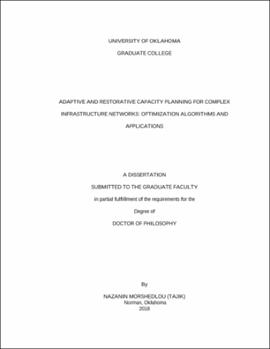| dc.contributor.advisor | Barker, Kash | |
| dc.contributor.author | Morshedlou (tajik), Nazanin | |
| dc.date.accessioned | 2018-05-08T16:38:31Z | |
| dc.date.available | 2018-05-08T16:38:31Z | |
| dc.date.issued | 2018 | |
| dc.identifier.uri | https://hdl.handle.net/11244/299804 | |
| dc.description.abstract | This research focuses on planning and scheduling of adaptive and restorative capacity enhancement efforts provided by complex infrastructure network in the aftermath of disruptive events. To maximize the adaptive capacity, we propose a framework to optimize the performance level to which a network can quickly adapt to post-disruption conditions by temporary means. Optimal resource allocation is determined with respect to the spatial dimensions of network components and available resources, the effectiveness of the resources, the importance of each element, and the system-wide impact to potential flows within the network. Optimal resource allocation is determined with respect to the spatial dimensions of network components and available resources, the effectiveness of the resources, the importance of each element, and the system-wide impact to potential flows within the network.
To optimize the restorative capacity enhancement, we present two mathematical formulations to assign restoration crews to disrupted components and maximize network resilience progress in any given time horizon. In the first formulation, the number of assigned restoration crews to each component can vary to increase the flexibility of models in the presence of different disruption scenarios. Along with considering the assumptions of the first formulation, the second formulation models the condition where the disrupted components can be partially active during the restoration process. We test the efficacy of proposed formulation, for adaptive and restorative capacity enhancement, on the realistic data set of 400-kV French electric transmission Network. The results indicate that the proposed formulations can be used for a wide variety of infrastructure networks and real-time restoration process planning.
Approaching the proposed formulations to reality introduces a synchronized routing problem for planning and scheduling restorative efforts for infrastructure networks in the aftermath of a disruptive event. In this problem, a set of restoration crews are dispatched from depots to a road network to restore the disrupted infrastructure network. Considering Binary and Proportional Active formulation, we propose two mathematical formulation in which the number of restoration crews assigned to each disrupted component, the arrival time of each assigned crew to each disrupted component and consequently the restoration rate associated with each disrupted component are considered as variables to increase the flexibility of the model in the presence of different disruptive events. To find the coordinated routes, we propose a relaxed mixed integer program as well as a set of valid inequalities which relates the planning and scheduling efforts to decision makers policies. The integration of the relaxed formulation and valid inequalities results in a lower bound for the original formulations. Furthermore, we propose a constructive heuristic algorithm based on the strong initial solution obtained from feasibility algorithm and a local search algorithm. Computational results on gas, water, and electric power infrastructure network instances from Shelby County, TN data, demonstrates both the effectiveness of the proposed model formulation, in solving small to medium scale problems, the strength of the initial solution procedure, especially for large-scale problems. We also prove that the heuristic algorithm to obtain the near optimal or near-optimal solutions. | en_US |
| dc.language | en_US | en_US |
| dc.subject | Infrastructure network resilience | en_US |
| dc.subject | Restorative capacity enhancement | en_US |
| dc.subject | Post disruption network performance optimization and solution Algorithms | en_US |
| dc.title | Adaptive and Restorative Capacity Planning for Complex Infrastructure Networks: Optimization Algorithms and Applications | en_US |
| dc.contributor.committeeMember | Nicholson, Charles | |
| dc.contributor.committeeMember | Gonzalez, Andres | |
| dc.contributor.committeeMember | Trafalis, Theodore | |
| dc.contributor.committeeMember | Radhakrishnan, Sridhar | |
| dc.contributor.committeeMember | Sansavini, Giovanni | |
| dc.date.manuscript | 2018-04-26 | |
| dc.thesis.degree | Ph.D. | en_US |
| ou.group | College of Engineering::School of Industrial and Systems Engineering | en_US |
| shareok.orcid | 0000-0002-9481-7307 | en_US |
